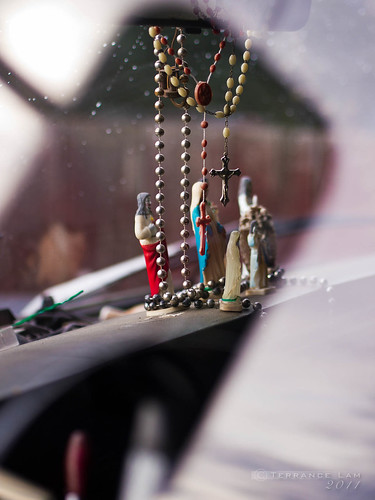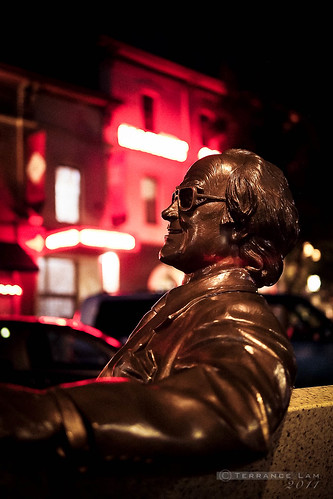 |
| Olympus M.Zuiko 12mm F/2, Panasonic/Leica Summilux 25mm F/1.4 & Olympus M.Zuiko 45mm F/1.8 |
Undoubtedly the three most significant lenses to grace the Micro Four Thirds format in the last 4 months are the prime lens offerings from both Panasonic and Olympus. These three lenses (in my opinion) make the perfect trio of primes that suit this format. The
Olympus 12mm F/2,
Leica 25mm F/1.4 and the
Olympus 45 F/1.8 (you'll fine my personal review of each lens on SLRGear.com under the user comments of 'kinematic').
 |
Olympus Pen E-P3 with the 12mm, 25mm & 45mm.
Small enough to all fit on a window sill |
On the 135 full frame format, some might say there are combinations like: 35mm F/1.4, 50mm F/1.2 & 85mm F/1.8 or 50mm F/1.2, 85mm F/1.2 & 135 F/2. Regardless, what seems to make a decent trio of lenses among most photographers, is being able to find a range that doesn't overlap the other in terms of function and accessibility.
I've never been one to buy into the idea of the 'Trinity' of lenses mostly because I tend to just collect lots of lenses on a whole, each for their different purposes and different attributes or a good quality zoom that covers all sorts of ranges. But in my evolution into the Micro Four Thirds system the biggest thing I appreciate is being able to keep my system very compact, but having the flexibility to do lenses changes that don't weigh down my shoulder or back on an outing.
 |
| Leica 25mm F/1.4 w/fill flash. |
Whether you believe in the system or not, for me, the biggest thrill is being able to get high quality images with a small compact system that rivals my bigger bodies. These three lenses makes the difference between what some might call a toy system, to a seriously grown up, enthusiasts or even professional set up.
I've seen arguments about bokeh or equivalent field of views compared to full frame, and frankly I think some people are just too hung up on justifying the systems that they have invested in, rather than opening up the perspective and possibilities of something more compact. I can tell you I certainly was one of those types until I got my hands onto the system and really worked with it (and I don't mean just trying it out in a store or even using it for a day).
 |
| Olympus 45mm F/1.8 |
In my past blog post about comparing the
5Dmk2 vs the E-P3 I looked at how the 25mm compared as a standard and parts of the results were different; frankly it was pretty minor when you looked at the overall results that came off of the smaller format. It's also important to look at individual results because in the end, the clients or the audience really doesn't care except for final results.
In the past couple of months, I've been pushing and challenging the system in all sorts of scenarios, and for the most part, it has met my expectations and then some. Bringing it along on all sorts of shoots as a back-up to my bigger bodies, I have ended up using it as a primary camera in some cases. The image quality and flexibility of the system quickly became apparent.
 |
| Olympus 12mm F/2 |
On one interior shoot, I had brought with me a classic 5D body with a set of wide angle lenses. At some point I found it much easier to use the Olympus Pen with the 12mm F/2. I had initially used that combination to look quickly for some compositional ideas while the bigger system sat on the tripod. I actually found that the photos I were taking with the Pen were sufficient enough that I didn't even need to retake them with the 5D.
 |
| handholding detail shots are a snap! |
The other benefit I found with the smaller system was the ability to take detail shots without needing to set-up tripods or moving around things. Leaving the primary system on the tripod, I just walked around with the pen to catch the detail shots necessary for completing my shoot.
The 12mm didn't disappoint me. It had little to no distortion and the corner to corner sharpness matched what my Canon EF 24mm F/1.4L II lens produces (one of my favourite lenses to use).
Of course most important in this whole mix is the price of this entire system. My 5DmkII with a 24mm lens runs around $4,000 USD. The E-P3 with the 12mm runs around $1,600. Certainly the resolution is a huge difference (21mp vs 12mp) but 12mp is more than plenty for a single full page magazine ad. All three lenses and the E-P3 still came in under $2600 which is what I sold my 7D and 100-400L to finance this system.
 |
| Olympus 45mm F/1.8 |
One of the other things I've had the opportunity to spend more time with is street photography. The winning combination of all three allows me a whole level of flexibility that the larger format systems were too unwieldy, obtrusive, and frankly made me look like a target during night photography. But despite individual comfort levels, I like the fact that I could easily put a lens in each jacket pocket and not need to carry a bulky bag making my outings more mobile.
Each of the three lenses are a blast to use on the street and each one have their pluses and minuses. Being prime lenses means you have to be aware of the field of view you're working with, but once you set your mind to what you're hoping to shoot, you can easily fit the session to a single lens. However the convenience of the other two lenses still remain at pocket's distance, getting yourself into the idea that you don't need to change lenses a lot is actually quite liberating.
 |
| 12mm using the 'Snap-Focus' for zone focus |
Aside from the bonus of adapting other lenses, I found this combination of lenses really covers most of my applications. The 12mm alone has a snap focus ring, so without using any viewfinder or preview, I'm able to zone focus my subjects and expect everything to be in focus, just like using classic rangefinders like the Leica system. Speaking of Leica, the Panasonic produced, Leica Summilux 25mm F/1.4 gives me the same compact image quality of a rangefinder, but also has the advantage of modern auto focus.
 |
| Leica 25mm F/1.4 |
Even in night photography, the lack of a focus ring with distance marking with the 25mm F/1.4 is really not a major deal. The Pen's autofocus is fast enough that even in low light and the 25mm F/1.4, that it's really quite easy to capture images on the street.
Even if you're a bokeh snob you'll be hard pressed to get this kind of image quality in a compact system from a zoom lens. Certainly one could argue that you could easily cover this entire range with something like a 24-70 F/2.8 and similar depth of field equivalencies but even that still runs nearly $4,000 again while the Pen and all three lenses are still well under that and far lighter.
The thing that many critics seem to overlook about the whole depth of field equivalency or the whole crop factor thing, is simply from a light transmission point of view, regardless of depth of field equivalency, an F/1.4 is still going to see better in less light than an F/2.8 and is the only real combination that can be used efficiently handheld in low light. That is certainly the difference of getting the shot or not.
 |
| Leica 25mm F/1.4 |
Despite all the fun I've been having with these three lenses, I am certainly finding more opportunities to use this in a professional and primary setting. Even in the classroom, I've been using this system to teach photography from. Frankly if I was to start all over again, I'd pair this with a medium format system like the Pentax 645D and never look back at the 135 format ever again. Of course in the end, I still love my 5Dmk2 and it's lens line up and all things said and done, the experience of getting out there and shooting is far more important than the system you use. The trinity of Micro Four Thirds primes does this for me, and being able to sit back and enjoy my world is far more important than getting hung up on who's system is better than the others... my motto for this system is simple: see, shoot, serenity...
 |
| 45mm F/1.8... at the end of the day, relax and enjoy. |











I can't wait to get my hands on the Leica 25mm. Unfortunately it won't be available here in the US until November.
ReplyDeleteI wonder what is holding it up getting there. You'll love it when you get it though.
ReplyDelete